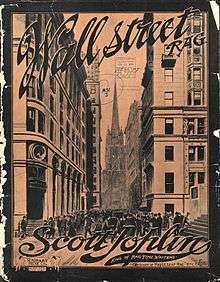Wall Street Rag
"Wall Street Rag" is a ragtime composition by Scott Joplin, first published in 1909. As indicated by the title, the theme is based on Wall Street following the events surrounding the Panic of 1907. This is represented in the musical structure along with its corresponding annotations.[1]
| Wall Street Rag | |
|---|---|
| by Scott Joplin | |
 The 1909 frontal cover of the sheet music looks down towards Trinity Church, and the dark-suited crowd in front of the Stock Exchange. | |
| Genre | Ragtime |
| Form | A Syncopated March and Two Step |
| Published | 1909 |
| Publisher | Seminary Music Co. of New York |
History
| Audio | |
|---|---|
| Video | |
In 1909, the "Wall Street Rag" by Scott Joplin was published.[1] The copyright was registered February 23, 1909 to Seminary Music Co. of New York.[2]
Musical structure
- Intro A A B B C C D D[2]
Unlike most of his rags during this time, this composition is based on a major historical event and features footnotes unique to the theme of this piece. Moreover, this arrangement uses a “Very Slow March Time” rather than the “Slow March Time” used in his other compositions.[3] The rag’s opening section begins with notes of Panic in Wall Street, Brokers feeling melancholy, representing the first phase of the recession. The next section of the rag moves from a Chopinesque chromatic style to the right-hand chords and bass octaves of Good times have come, providing an atmosphere of hope within the crisis. The rag finally closes with financial worries chased away during economic revitalization while folks Listening to the strains of genuine negro ragtime, brokers forget their cares.
Legacy
Ragtime scholar John E. Roache praised "Wall Street Rag", saying that it was "ragtime taken to a higher level."[4]
According to one progressive commentator, Joplin challenges the myth that "what’s good for Wall Street is good for America."[3]
See also
References
- Edwards, Bill. "Rags and Pieces by Scott Joplin (1906-1917)". RAGPIANO. Retrieved 16 March 2017.
- Jasen, David A.; Trebor Jay Tichenor (1978). Rags and Ragtime: A Musical History. New York, NY: Dover Publications, Inc. p. 93. ISBN 0-486-25922-6.
- YEARSLEY, DAVID. "How Scott Joplin Had Wall Street Down". counterpunch. Retrieved 16 March 2017.
- Roache, John E. (1999). "Wall Street Rag, Scott Joplin". John Roache's Ragtime MIDI Library. Retrieved 20 November 2003.